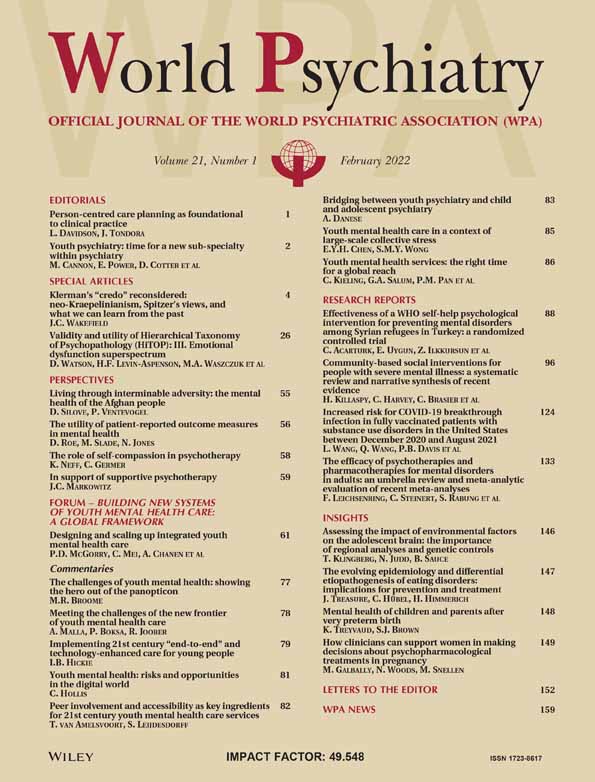All-cause and cause-specific mortality in people with depression: a large-scale systematic review and meta-analysis of relative risk and aggravating or attenuating factors, including antidepressant treatment.
IF 65.8
1区 医学
Q1 Medicine
引用次数: 0
Abstract
Depression has been reported to be associated with premature mortality. However, no meta-analysis has comprehensively examined all-cause and cause-specific mortality risk in people with this condition, focusing also on possible aggravating and attenuating factors, including antidepressant treatment. We conducted a systematic review and meta-analysis of cohort studies to synthesize mortality risk estimates associated with depression (major depressive disorder and dysthymia) due to any and specific causes, and when depression is accompanied by comorbid conditions. Effects of antidepressant medication and electroconvulsive therapy (ECT), and other potential moderators of mortality risk, were evaluated. We searched EMBASE, Medline and PsycINFO databases up to January 26, 2025, pooling mortality estimates using random-effect models. Publication bias, subgroup and meta-regression analyses, and quality assessment (Newcastle-Ottawa Scale) were performed. Across 268 studies, 10,842,094 individuals with depression and 2,837,933,536 control subjects were included. All-cause mortality was doubled in people with depression versus no depression/general population controls (relative risk, RR=2.10, 95% CI: 1.87-2.35, I2=99.9%), being especially high for suicide (RR=9.89, 95% CI: 7.59-12.88, I2=99.6%), but also elevated for natural causes (RR=1.63, 95% CI: 1.51-1.75, I2=99.6%). Among individuals with versus without depression matched for comorbid conditions, the depression-associated mortality risk was also significantly elevated (RR=1.29, 95% CI: 1.21-1.37, I2=99.9%). Depression with versus without psychotic symptoms (RR=1.61, 95% CI: 1.45-1.78, I2=6.3%), and treatment-resistant versus non-treatment-resistant depression (RR=1.27, 95% CI: 1.16-1.39, I2=85.3%), conferred an incremental mortality risk. Antidepressant use (versus no antidepressant use) was associated with significantly lower all-cause mortality in people with depression (RR=0.79, 95% CI: 0.68-0.93, I2=99.2%). ECT use (versus no ECT use) was associated with reduced all-cause mortality (RR=0.73, 95% CI: 0.66-0.82, I2=0%), natural-cause mortality (RR=0.76, 95% CI: 0.59-0.97, I2=12.0%), and suicide (RR=0.67, 95% CI: 0.53-0.85, I2=32.3%). Our results affirm heightened mortality risk in depression, identify clinically relevant patient subgroups with increased mortality risk, and highlight mortality-reducing effects of antidepressant treatment and ECT. Multipronged intervention approaches targeting physical health improvement and suicide risk alleviation, optimizing antidepressant treatment, and pursuing early identification and effective interventions for psychotic and treatment-resistant depression, could help reduce this mortality gap, which is still growing.抑郁症患者的全因和特定原因死亡率:一项大规模系统回顾和相对风险及加重或减轻因素的荟萃分析,包括抗抑郁治疗。
据报道,抑郁症与过早死亡有关。然而,没有荟萃分析全面检查了这种疾病患者的全因和病因特异性死亡风险,也关注了可能加重和减轻的因素,包括抗抑郁药物治疗。我们对队列研究进行了系统回顾和荟萃分析,以综合与抑郁症(重度抑郁症和心境恶劣)相关的死亡率风险估计,这些抑郁症是由任何和特定原因引起的,并且伴有合并症。评估了抗抑郁药物和电休克治疗(ECT)以及其他潜在的死亡风险调节剂的效果。我们检索了EMBASE、Medline和PsycINFO数据库,截止到2025年1月26日,使用随机效应模型汇总死亡率估计。进行了发表偏倚、亚组和元回归分析以及质量评估(纽卡斯尔-渥太华量表)。在268项研究中,包括10,842,094名抑郁症患者和2,837,933,536名对照受试者。抑郁症患者的全因死亡率是无抑郁症/普通人群对照组的两倍(相对危险度,RR=2.10, 95% CI: 1.87-2.35, I2=99.9%),自杀死亡率尤其高(RR=9.89, 95% CI: 7.59-12.88, I2=99.6%),但自然原因死亡率也升高(RR=1.63, 95% CI: 1.51-1.75, I2=99.6%)。在与合并症相匹配的抑郁症患者与非抑郁症患者中,抑郁症相关的死亡风险也显著升高(RR=1.29, 95% CI: 1.21-1.37, I2=99.9%)。有精神病性症状的抑郁症与无精神病性症状的抑郁症(RR=1.61, 95% CI: 1.45-1.78, I2=6.3%)以及治疗难治性抑郁症与无治疗难治性抑郁症(RR=1.27, 95% CI: 1.16-1.39, I2=85.3%)均增加了死亡风险。使用抗抑郁药(与不使用抗抑郁药相比)与抑郁症患者全因死亡率显著降低相关(RR=0.79, 95% CI: 0.68-0.93, I2=99.2%)。使用ECT(与不使用ECT相比)与降低全因死亡率(RR=0.73, 95% CI: 0.66-0.82, I2=0%)、自然原因死亡率(RR=0.76, 95% CI: 0.59-0.97, I2=12.0%)和自杀(RR=0.67, 95% CI: 0.53-0.85, I2=32.3%)相关。我们的研究结果证实了抑郁症的死亡风险增加,确定了临床相关的死亡风险增加的患者亚组,并强调了抗抑郁药物治疗和ECT的降低死亡率的作用。针对改善身体健康和减轻自杀风险的多管齐下的干预方法,优化抗抑郁药物治疗,以及对精神病性和治疗难治性抑郁症进行早期识别和有效干预,可以帮助缩小这一死亡率差距,这一差距仍在扩大。
本文章由计算机程序翻译,如有差异,请以英文原文为准。
求助全文
约1分钟内获得全文
求助全文
来源期刊

World Psychiatry
Nursing-Psychiatric Mental Health
CiteScore
64.10
自引率
7.40%
发文量
124
期刊介绍:
World Psychiatry is the official journal of the World Psychiatric Association. It aims to disseminate information on significant clinical, service, and research developments in the mental health field.
World Psychiatry is published three times per year and is sent free of charge to psychiatrists.The recipient psychiatrists' names and addresses are provided by WPA member societies and sections.The language used in the journal is designed to be understandable by the majority of mental health professionals worldwide.
 求助内容:
求助内容: 应助结果提醒方式:
应助结果提醒方式:


